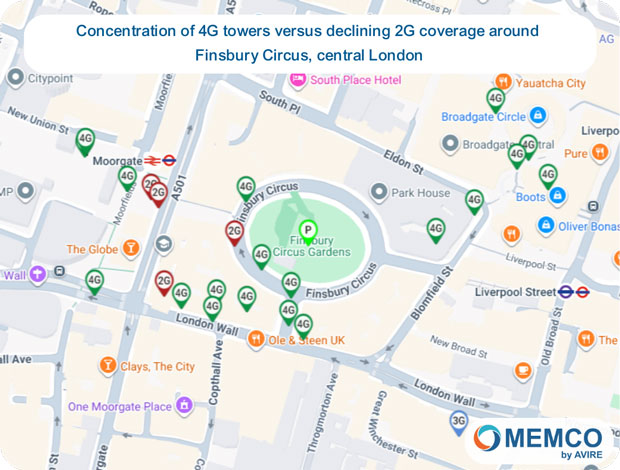An interview with Matthew Davies, Business Development Manager, Digital & Services, MEMCO by AVIRE
From October 2025, Virgin Media O2 (VMO2) will end inbound roaming access to its 2G network. While the headline may sound technical, the implications for building safety, particularly in relation to lift emergency communications, are serious. We spoke with Matthew Davies from MEMCO by AVIRE to unpack what this means, why it matters now, and what action facilities professionals should take.
Q: What exactly is changing with the O2 2G network?
In October, VMO2 will prevent SIM cards from roaming (connecting) to its 2G network. If your lift alarm system uses a 2G or 3G gateway and the SIM inside is not from VMO2, it will no longer connect to the VM02 2G network.
Many lift alarms use roaming SIMs that are designed to connect to whichever network offers the best signal. However, with 3G networks already shut down in the UK, many devices are currently surviving only by falling back to 2G. This fallback will end in many cases this October.
Q: Is the issue limited to VMO2 customers only?
No, and that is where the risk of complacency arises. Even if your building is on a different provider, your gateways could still be using roaming onto VMO2’s 2G infrastructure in certain areas. While EE, Vodafone, and Three have not confirmed their 2G shutdown dates, the direction is clear: 2G is going away
Across Europe, 2G and 3G networks are being decommissioned to make room for newer technology. Australia and Switzerland have already completed their shutdowns. France and Spain have announced plans to phase out 2G from 2025. According to Ofcom, UK mobile operators have committed to retiring 2G and 3G networks by 2033 at the latest, but reductions in coverage and investment are already happening. This trend will continue, so the time to act is now.
Q: What could facilities managers expect if their lift alarms are still using 2G?
Best case, you may start seeing degraded signal quality, dropped calls, or longer connection times during testing. Worst case, the device will no longer connect to the mobile network. If the lift alarm cannot place a call, that becomes a defect under Lifting Operations and Lifting Equipment Regulations (LOLER) inspections, which then must be resolved within a defined timeframe.
We are already seeing an increase in low signal alerts from 2G-connected devices in locations such as Glasgow, Birmingham and Liverpool. This indicates that changes are already underway.
Q: What are the biggest hidden risks for teams that haven’t acted yet?
Assuming mobile-connected lift alarms are unaffected by these changes is a major risk. The PSTN switch-off created a similar pattern of delays and misunderstandings. For example: Many people assume that a 4G device guarantees 4G connectivity, but unless it is configured for 4G-only mode, it may still fall back to 2G under certain conditions. That fallback may soon fail silently.
If the building is in an area where VMO2 provides the only reliable signal, that alarm may stop working.
Q: What common mistakes do people make when they try to upgrade last-minute?
Rushing into hardware replacements without fully understanding the solution. Some 4G gateways being marketed “for lifts” do not include battery backup. That means if there is a power outage, which is often when lift entrapments occur, the alarm system connection fails along with the mains.
Another mistake is choosing SIM cards that only roam on 2G networks. Some lower-cost roaming options still prioritise 2G signals, even in a 4G-capable device. Ask your provider whether your SIM supports 4G roaming across all UK networks and whether the device will prioritise that connectivity.
So what’s the best way to future-proof lift emergency communications now?
First, identify and replace any 2G or 3G-only devices in your portfolio. Upgrade to 4G-enabled gateways that operate in 4G-only mode and have power resilience, such as battery backup.
Second, understand what type of SIM card you are using. It should be a non-steered roaming SIM that selects the strongest available signal rather than a preferred network, and it must operate on the 4G band.
Finally, consider adopting a managed communications service, such as SENTINEL offered by MEMCO by AVIRE. These services typically include equipment upgrades, remote monitoring, SIM updates, and battery changes. This reduces the operational burden and ensures you’re ready for the next infrastructure change, whether that involves a4G sunset or other roaming restrictions in the future.
Q: What practical steps should facilities managers take now?
Audit your lift portfolio. Ask:
- What devices are installed?
- Are they 2G, 3G, or 4G?
- Are they configured to run on 4G-only?
- What type of SIM card is being used?
- Does it support full 4G roaming?
Do not wait for a LOLER inspection to identify a defect or a tenant to report a failed alarm. Proactive planning means better control over costs, engineer availability, and upgrade options.
Once VMO2 shuts off roaming in October, other networks will follow. The earlier you act, the less disruption you face.





